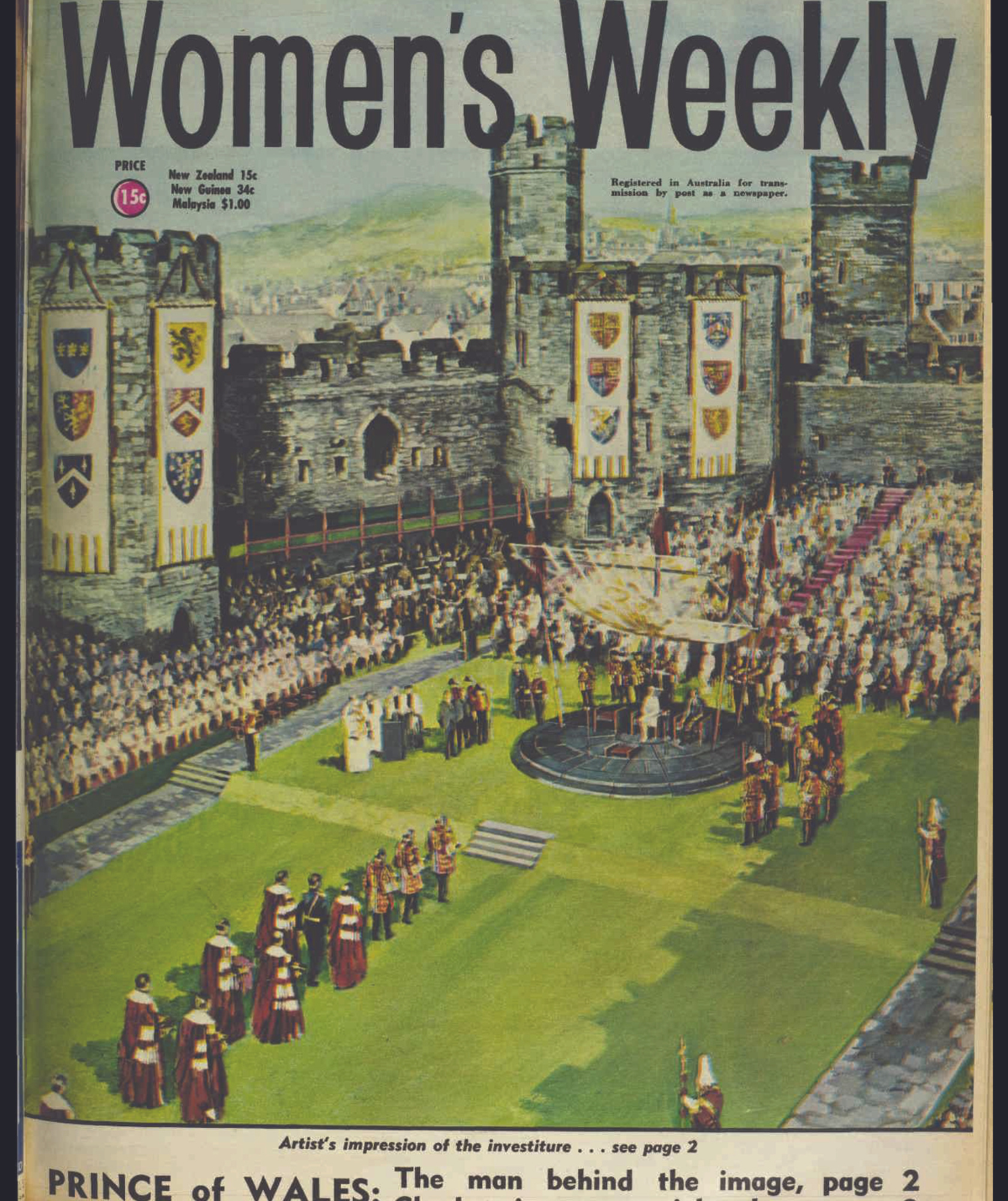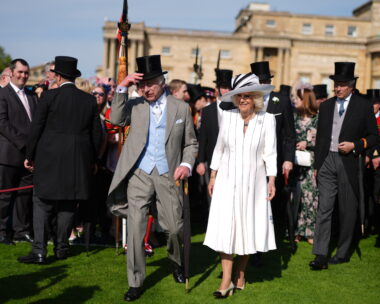Charles will be invested Prince of Wales amid ancient and modern pomp and splendour. It is only the second time that the ceremony has been performed in the setting in which the story of the Prince of Wales began 700 years ago. But the traditions have survived, and many features of Prince Charles’ investiture have their origins in those feudal days. Then, so legend has it, to help pacify the Welsh, who for years had been fiercely resisting their conquerors, King Edward I ordered his queen, Eleanor, to Caernarvon Castle for the birth of their child.
Within hours of her arrival, after a long and arduous journey from London, her son was born. A delighted King strode out to face the group of hardy, rough-clad, surly Welshmen gathered in the courtyard.
“You have demanded from me a prince of your own,” he said. “One born in Wales to replace your own dead princes.” And dramatically raising the newborn babe above his head, Edward announced, “This is your man!”
Which, in essence, is what the Queen will be doing when she presents Prince Charles to the people of Wales from those castle gates to a fanfare from trumpeters perched high in the walls.

The 700 years that have passed since the first Prince of Wales was held up to placate a resentful people will be telescoped into this moment of history that is Prince Charles’. The Prince is a very modern young man, and his investiture in a modern world has presented problems that never before had to be faced.
The last investiture was in 1911, when a 16-year-old Prince Edward, with his golden hair and direct, friendly gaze, dressed in a white satin suit with knee-breeches beneath a heavy velvet cloak, knelt before his father, King George V, to swear himself “liege man”.
Seventeen thousand privileged people crowded into the courtyard of Caernarvon Castle for that investiture, and a few discreetly placed photographers recorded the scene.
Artists gave the world an idealised portrait of the young Prince Charming – now the Duke of Windsor.
This is the day of television, and for presenting the investiture to 500,000,000 viewers across the world, someone with a sense of theatre was needed to prepare the castle. The Queen did not have to look far.
Lord Snowdon was appointed Constable of Caernarvon Castle, and he soon showed he was not just a figurehead. With his friend Carl Toms, talented theatre designer, responsible for the overall decor, and designer John Pound for such specific things as the much-talked-about chairs which are to be knocked down after the ceremony and may be bought (for $A25.80) by those who have sat on them – Lord Snowdon worked to show the uncluttered beauty of Caernarvon Castle and make sure that the whole of the investiture could be followed by the cameras.
“It will be like theatre in the round,” Lord Snowdon told me as we went, step by step, over the setting for the investiture, ready now except for a few last-minute touches.
Caernarvon Castle is a perfect setting for ceremonial events. So perfect, in fact, that Lord Snowdon agreed with Carl Toms that there would be no red carpet, no marquees, no banks of hydrangeas or tubs of geraniums. Nothing to intrude on the textures of old stone.

Her Majesty the Queen adjusts the robe of her oldest son, Prince Charles, during his lavish investiture as the Prince of Wales.
(Credit: Getty)Television has, naturally, dominated much of the thinking, and many hours of hard work and thought went into a perspex canopy, in medieval design, to cover the throne dais, giving an unobstructed view to guests and cameras.
The dais is of Welsh slate, and the thrones are made with simple slabs of stone. “They could have been → at Stonehenge,” said Tony Snowdon. “And I hope that after the investiture they will stay at Caernarvon.”
Carl Toms and Tony both confessed that, with everything kept as simple as possible, there was the danger that it would be too austere.
“Aesthetically the slate was the most beautiful medium to work in, but colour was needed,” said Tony.
For a while the designers were stuck for a fabric to cover the chairs inside the castle and the cushions on the platform seating outside. “Something to go with stone,” said Tony.
“Velvet,” said Carl Toms, “would not work. It doesn’t look right in broad daylight. So we decided on red flannel.”
A search of Wales began, and a Welsh member of the team, after 900 miles on a round trip, came up with enough old-fashioned red flannel to do the job.
“Nothing looked as right as this vermilion flannel.
It’s a sympathetic fabric,” Carl said.
When “Jones the wool shop” heard the news, he threw up his hands in horror. “It’s what we sell for keeping the old ones warm and for babies’ binders.”
“It’s medicinal,” Tony – Jones the castle – smiled. And now, with every gas and electricity showroom proudly displaying some of the chairs, everyone is delighted with the effect. The red flannel enhances the Prince of Wales feathers, in gold.
It was “Jones the castle’s” idea to show the public what they would get for their money. Tony’s long-term plans are to attract more visitors to Caernarvon. “We expect 30,000 here this summer,” he said in the anticipatory tone you hear when owners throw their old ancestrals open to the public.
“I like to think we have not only done this work for the investiture but for the years ahead.”

Her Majesty is joined at the castle by her sister Princess Margaret, Princess Anne and the Queen Mother.
(Credit: Getty)The investiture ceremony will take up to five hours, starting with processions converging through the streets.
More than three-quarters of the guests waiting at the castle will be Welsh. Starting with their national anthem, Ancient Land of My Fathers, there will be a program of music, much of it composed for the occasion. Personalities who will help bring the scene to the vast outside audience will include Richard Burton, returning to his native Wales to describe it on television.
At the castle’s Water Gate, Lord Snowdon will receive the two royal processions, led by the Queen and Prince Charles. The Prince has contrived to be excused from wearing satin knee-breeches, so disliked by his great-uncle David, and will wear a purple velvet cloak over the ceremonial uniform of the Royal Regiment of Wales, of which he is now Colonel-in-Chief.
Having sworn his allegiance to the Queen and exchanged with her the “kiss of fealty”, Charles will take his seat on the slate throne beside her, Prince Philip being seated on the throne to her left.
Then the religious part of the ceremony will follow, in both Welsh and English. The blessing will be in Welsh only.
The Queen, accompanied by Prince Philip, will present the Prince to the people at three points, to fanfares of trumpets heralding their arrival at Queen Eleanor’s Gate, King’s Gate and the Lower Ward.
More fanfares will announce the royal family’s departure along the two-mile processional route. Finally, they will go on board the royal yacht Britannia. The next day Prince Charles will begin a four-day tour of Wales, a meet-the-people visit by yacht, car, helicopter and small boat, planned to be as informal as possible.
And for three months Wales will continue its celebration with festivals, carnivals, contests and fairs



